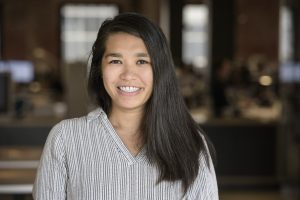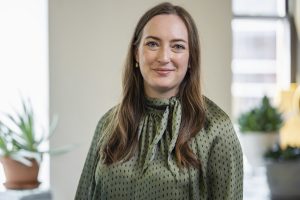
- This event has passed.
Eliminating Vinyl in the Built Environment: What are the Alternatives?
October 11, 2023 @ 12:00 pm - 1:00 pm PDT
Free
To create healthier buildings, we strive to eliminate unhealthy materials, such as vinyl, from the built environment. This course will provide an understanding of the impact vinyl can have on human health through a brief overview of vinyl’s chemical make-up and manufacturing process. The course will primarily focus on alternate healthy materials to avoid regrettable substitutions. Designers will understand the pros and cons of each material substitute and learn how to engage with stakeholders to abstain in the selection of vinyl products.
Moderator

Kathleen Hetrick, Sustainability Engineer
Kathleen Hetrick is a sustainability engineer at Buro Happold and a LEED AP BD+C and EcoDistricts AP. As part of Buro Happold’s sustainability and physics team, Kathleen combines her passion for human-focused sustainable design with a technical background in mechanical engineering. She has experience in a wide range of cutting-edge projects across all scales of work including multiple LEED platinum projects, Living Building Challenge projects, historical adaptive reuse, LEED Neighborhood Developments, and city and campus sustainability plans.
Speakers

Adrienne Rosca, LFA, Fitwel Ambassador
Adrienne is an Associate and Project Manager in Austin, Texas. She received her Bachelor of Architecture at Woodbury University, is a Fitwel Ambassador and LFA Accredited. With a focus on multi-family housing, Adrienne has spent the last 10 years of her career working on mixed-use, urban infill, student housing, and affordable housing. At Steinberg Hart, she is the Chair of the Material Co-Lab group, where she works alongside her colleagues to advocate for low-carbon, healthy and equitably sourced materials and led the Fitwel certification process for the Austin Office.

Alyson Kritz, NCIDQ, LFA, Fitwel, LEED Green Associate
Alyson designs inspiring and functional spaces with a unique sense of quality, care, and attention to detail. She applies evidence-based design principles to her projects which allow spaces to be planned, programmed, designed, and constructed effectively. Client needs are prioritized, and expectations exceeded as she guides projects through a creative and collaborative design process. Her background in civic, cultural, educational, and workplace design spans across the United States and varies from minor renovations to state-wide masterplans. She creatively balances color and material to reflect each project’s location, culture, and community. Her dedication to sustainability, biophilic design principles, and ethical material selection is ingrained into all projects regardless of budget, aesthetic, or timeline.

Javaria Farooq, Fitwel Ambassador
Javaria designs timeless interiors that carry a unique sense of quality, and attention to detail. She uses design as a medium to creatively reflect and preserve each project’s culture and community, unique to its location. Javaria uses a lense of sustainability, wellbeing and social ethics, to craft a thoughtful selection of materials into every project. Her commitment to healthy interiors begins from the conceptual design phase and she joins these design principles together with a sophisticated eye for color and material to transform interior spaces.
Eliminating Vinyl in the Built Environment: What are the Alternatives? POWERPOINT PRESENTATION
YOUTUBE VIDEO: Eliminating Vinyl in the Built Enviornment
Approved Learning Objectives AIA CES: 1 LU|HSW:
Learning Objective 1:
Participants will gain a better understanding of negative vinyl impacts to human and environmental health, through an overview of vinyl’s chemical make-up and manufacturing process.
Learning Objective 2:
Participants will be able to identify alternate materials for building exteriors, in order to work towards eliminating vinyl products in the built environment and create healthier buildings.
Learning Objective 3:
Participants will explore alternate materials for interior finishes, the pros and cons of each material substitute, and how to avoid regrettable substitutions.
Learning Objective 4:
Participants will be able to develop strategies to engage with other stakeholders, including manufacturers, clients, and consultants, so that they have the ability to filter through greenwashing and advocate for/specify non-toxic products in an educated manner.
The session focuses on eliminating vinyl products in the built environment by educating designers on alternate materials and avoiding regrettable substitutions. Vinyl is a red list chemical and has negative impacts to human health and environmental health. The course will also teach designers how to engage with manufacturers, clients, and consultants so that they have the ability to filter through greenwashing and advocate for/specify non-toxic products in an educated manner.
Sponsored by:
![]()







